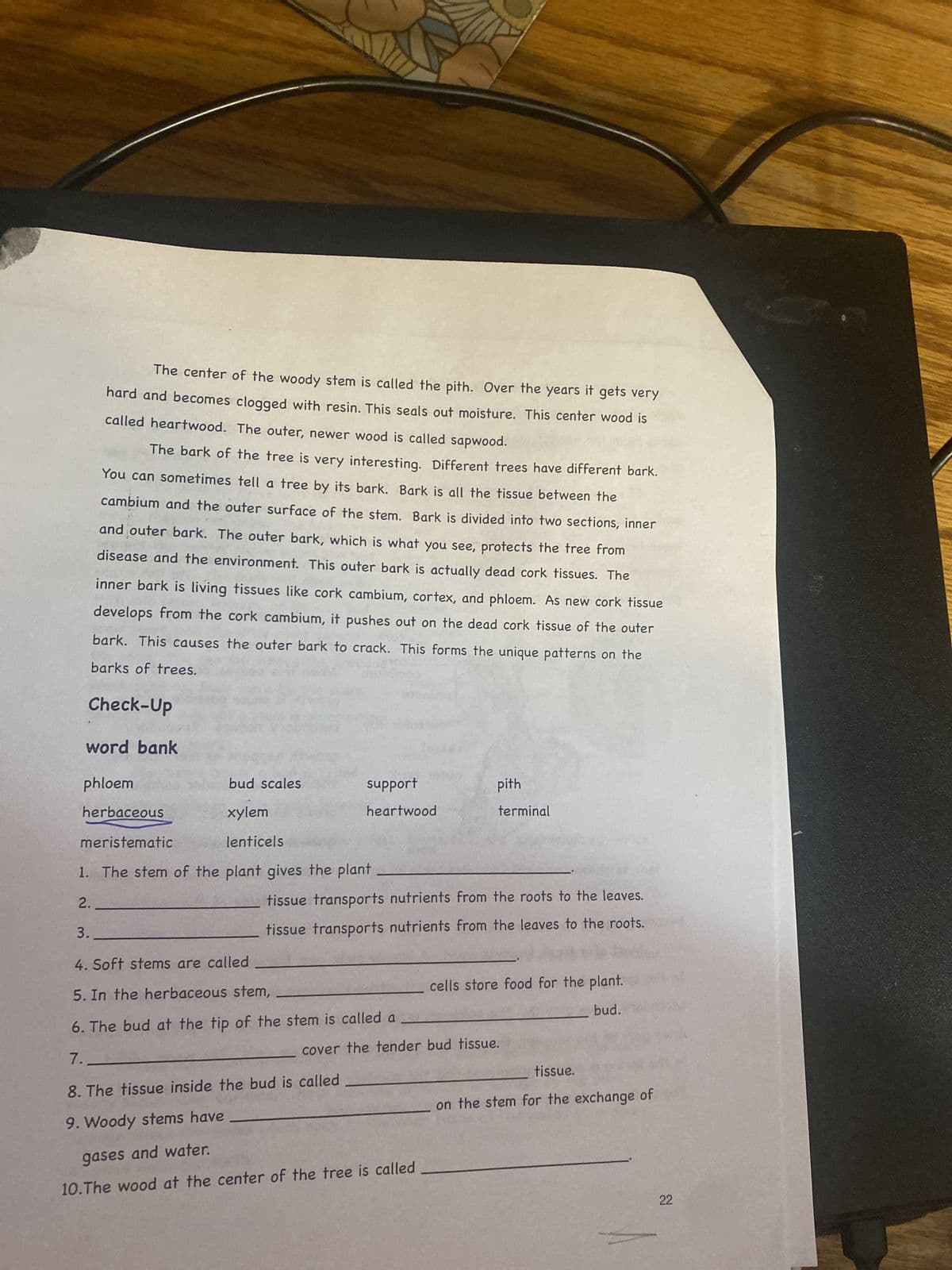The center of the woody stem is called the pith. Over the years it gets very hard and becomes clogged with resin. This seals out moisture. This center wood is called heartwood. The outer, newer wood is called sapwood. The bark of the tree is very interesting. Different trees have different bark. You can sometimes tell a tree by its bark. Bark is all the tissue between the cambium and the outer surface of the stem. Bark is divided into two sections, inner and outer bark. The outer bark, which is what you see, protects the tree from disease and the environment. This outer bark is actually dead cork tissues. The inner bark is living tissues like cork cambium, cortex, and phloem. As new cork tissue develops from the cork cambium, it pushes out on the dead cork tissue of the outer bark. This causes the outer bark to crack. This forms the unique patterns on the barks of trees. Check-Up word bank phloem herbaceous meristematic bud scales xylem support heartwood pith terminal lenticels 1. The stem of the plant gives the plant 2. 3. tissue transports nutrients from the roots to the leaves. tissue transports nutrients from the leaves to the roots. 4. Soft stems are called 5. In the herbaceous stem, cells store food for the plant. 6. The bud at the tip of the stem is called a bud. 7. cover the tender bud tissue. 8. The tissue inside the bud is called tissue. 9. Woody stems have gases and water. 10.The wood at the center of the tree is called on the stem for the exchange of 22 22
The center of the woody stem is called the pith. Over the years it gets very hard and becomes clogged with resin. This seals out moisture. This center wood is called heartwood. The outer, newer wood is called sapwood. The bark of the tree is very interesting. Different trees have different bark. You can sometimes tell a tree by its bark. Bark is all the tissue between the cambium and the outer surface of the stem. Bark is divided into two sections, inner and outer bark. The outer bark, which is what you see, protects the tree from disease and the environment. This outer bark is actually dead cork tissues. The inner bark is living tissues like cork cambium, cortex, and phloem. As new cork tissue develops from the cork cambium, it pushes out on the dead cork tissue of the outer bark. This causes the outer bark to crack. This forms the unique patterns on the barks of trees. Check-Up word bank phloem herbaceous meristematic bud scales xylem support heartwood pith terminal lenticels 1. The stem of the plant gives the plant 2. 3. tissue transports nutrients from the roots to the leaves. tissue transports nutrients from the leaves to the roots. 4. Soft stems are called 5. In the herbaceous stem, cells store food for the plant. 6. The bud at the tip of the stem is called a bud. 7. cover the tender bud tissue. 8. The tissue inside the bud is called tissue. 9. Woody stems have gases and water. 10.The wood at the center of the tree is called on the stem for the exchange of 22 22
Biology (MindTap Course List)
11th Edition
ISBN:9781337392938
Author:Eldra Solomon, Charles Martin, Diana W. Martin, Linda R. Berg
Publisher:Eldra Solomon, Charles Martin, Diana W. Martin, Linda R. Berg
Chapter33: Plant Structure, Growth, And Development
Section: Chapter Questions
Problem 6TYU
Related questions
Question

Transcribed Image Text:The center of the woody stem is called the pith. Over the years it gets very
hard and becomes clogged with resin. This seals out moisture. This center wood is
called heartwood. The outer, newer wood is called sapwood.
The bark of the tree is very interesting. Different trees have different bark.
You can sometimes tell a tree by its bark. Bark is all the tissue between the
cambium and the outer surface of the stem. Bark is divided into two sections, inner
and outer bark. The outer bark, which is what you see, protects the tree from
disease and the environment. This outer bark is actually dead cork tissues. The
inner bark is living tissues like cork cambium, cortex, and phloem. As new cork tissue
develops from the cork cambium, it pushes out on the dead cork tissue of the outer
bark. This causes the outer bark to crack. This forms the unique patterns on the
barks of trees.
Check-Up
word bank
phloem
herbaceous
meristematic
bud scales
xylem
support
heartwood
pith
terminal
lenticels
1. The stem of the plant gives the plant
2.
3.
tissue transports nutrients from the roots to the leaves.
tissue transports nutrients from the leaves to the roots.
4. Soft stems are called
5. In the herbaceous stem,
cells store food for the plant.
6. The bud at the tip of the stem is called a
bud.
7.
cover the tender bud tissue.
8. The tissue inside the bud is called
tissue.
9. Woody stems have
gases and water.
10.The wood at the center of the tree is called
on the stem for the exchange of
22
22
AI-Generated Solution
Unlock instant AI solutions
Tap the button
to generate a solution
Recommended textbooks for you

Biology (MindTap Course List)
Biology
ISBN:
9781337392938
Author:
Eldra Solomon, Charles Martin, Diana W. Martin, Linda R. Berg
Publisher:
Cengage Learning


Biology 2e
Biology
ISBN:
9781947172517
Author:
Matthew Douglas, Jung Choi, Mary Ann Clark
Publisher:
OpenStax

Biology (MindTap Course List)
Biology
ISBN:
9781337392938
Author:
Eldra Solomon, Charles Martin, Diana W. Martin, Linda R. Berg
Publisher:
Cengage Learning


Biology 2e
Biology
ISBN:
9781947172517
Author:
Matthew Douglas, Jung Choi, Mary Ann Clark
Publisher:
OpenStax